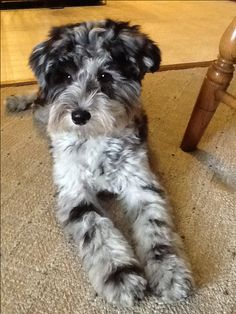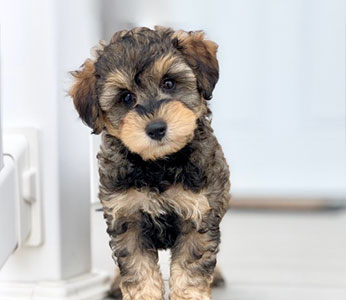Mini Schnoodle Breed Information


The Mini Schnoodle is an adorable, small designer dog breed that comes from crossing a Miniature Schnauzer with a Miniature Poodle. Combining the best traits of both breeds, these dogs are smart, playful, and incredibly affectionate, making them wonderful companions for families, singles, and seniors alike. With their energetic and friendly personalities, Mini Schnoodles are a popular choice for those looking for a low-shedding, hypoallergenic pet that thrives on companionship.
Thanks to their small size and adaptable nature, Mini Schnoodles fit well in a variety of living environments—from apartments to houses with large yards. They are great with children and generally get along with other pets, making them a versatile addition to most homes. Mini Schnoodles are known for their intelligence and trainability, which means they excel in learning new tricks and commands, but they also require regular mental stimulation to keep them happy.
Characteristics
- Small to Medium Size: Mini Schnoodle adults usually weigh between 10-20 pounds and stand about 12-15 inches tall. Their compact size makes them ideal for both apartment living and homes with limited space.
- Hypoallergenic Coat: Thanks to their Poodle lineage, Mini Schnoodle dogs often have a low-shedding, hypoallergenic coat. They are a great option for people with allergies.
- Energetic and Playful: These dogs are known for their moderate energy levels and playful nature. They love to run, chase, and play with toys.
- Highly Intelligent: With genes from two highly intelligent breeds, Mini Schnoodles are quick learners and enjoy mental challenges. This makes training them easier and more enjoyable.
- Affectionate and Loyal: Mini Schnoodles are known to form strong bonds with their families. They are loyal, loving dogs who thrive on human attention and companionship.
- Great with Kids and Other Pets: These dogs are generally good-natured and friendly. They are well-suited for families with children and other pets, provided they are properly socialized.
- Alert and Protective: Thanks to their Schnauzer background, Mini Schnoodles tend to be alert and make excellent watchdogs. They’ll often bark to alert their owners of any potential intruders or unfamiliar noises.

Appearance
The Mini Schnoodle is a charming little dog with a distinctive and adorable appearance, often described as a perfect blend of its Schnauzer and Poodle parents. Their size is typically small to medium, with an average height of 12 to 15 inches at the shoulder and a weight ranging from 10 to 20 pounds for a mini Schnoodle adult, depending on the specific genetics of the parents. This compact size makes them ideal for small living spaces, but their sturdy build also means they’re well-suited for active play.
Mini Schnoodles often inherit the curly or wavy coat of the Poodle, which gives them a soft and fluffy appearance. Their coats can come in a variety of colors, including black, white, gray, brown, apricot, or even a mix of these colors. Their coats tend to be low-shedding and hypoallergenic, which is one of the major draws for allergy-sensitive owners. Grooming styles can also influence their look—some owners prefer a “teddy bear” cut to accentuate their cuteness, while others go for a more trimmed, clean look.
Their expressive faces often feature the Schnauzer’s distinctive beard and eyebrows, giving them an endearing and sometimes almost human-like appearance. Mini Schnoodles typically have dark, intelligent eyes and floppy ears, which add to their overall lovable and approachable look. Their appearance is not just cute but functional, as their coat protects them from various weather conditions while still being easy to manage for most pet owners.
Temperament
The Mini Schnoodle is known for its friendly, affectionate, and outgoing temperament. These dogs thrive on human interaction and are happiest when they are spending time with their families. Whether it's cuddling on the couch, going for a walk, or playing in the yard, Mini Schnoodles love being part of the action. Their playful and energetic personalities make them excellent companions for active households, and they are great with both kids and adults alike. Despite their small size, Mini Schnoodles have big personalities and are known to form strong, loyal bonds with their owners.
These dogs are also highly social and generally get along well with other pets, especially when they are properly socialized from a young age. Because of their Schnauzer heritage, they can sometimes be a bit wary of strangers, but they usually warm up quickly once they sense that there's no threat. Mini Schnoodles are also known for their alertness and will often bark to let their owners know if someone is approaching the house. They are effective little watchdogs.
Another notable trait of the Mini Schnoodle is its intelligence. Both Schnauzers and Poodles are known for being smart breeds, and the Mini Schnoodle inherits this trait in spades. This intelligence, combined with their eagerness to please, makes them highly trainable. They enjoy mental challenges and thrive in environments where they can learn new tricks or engage in activities that stimulate their minds. However, this also means that they need regular mental and physical stimulation to prevent boredom, which can lead to unwanted behaviors.
Care
Grooming
The Mini Schnoodle's grooming requirements are moderate, primarily due to their Poodle-influenced coat. Their curly or wavy fur tends to be low shedding, which is a big plus for people with allergies, but it does require regular upkeep to prevent matting and tangles. It's recommended to brush your Mini Schnoodle’s coat at least two to three times a week, using a slicker brush or comb to keep it smooth and tangle-free. Regular brushing will also help distribute natural oils through their coat and keep it healthy and shiny.
In addition to brushing, Mini Schnoodles benefit from professional grooming every 6 to 8 weeks. This includes trimming their coat to maintain a neat appearance, as well as keeping their facial hair clean, particularly around their eyes and muzzle. Many owners opt for a "teddy bear" cut or a simple trim to make their Schnoodle’s coat easier to manage. Regular grooming also includes checking and cleaning their ears, as their floppy ears can sometimes trap moisture.
Other important grooming tasks include nail trimming and dental care. Their nails should be trimmed every few weeks to prevent overgrowth, which can cause discomfort or affect their gait. Additionally, brushing their teeth two to three times a week can help prevent dental problems like plaque buildup or gum disease.
Exercise Needs
Mini Schnoodles are energetic dogs that need regular exercise to stay healthy and happy. A daily walk of 30 to 45 minutes is usually sufficient to burn off their energy, but they also enjoy playtime, such as fetch or running around in a secure yard. These little dogs are more than happy to join in on family activities and can easily adapt to a more active lifestyle if needed.
While they don’t require hours of intense exercise, mental stimulation is just as important as physical activity for a Mini Schnoodle. Puzzle toys, training sessions, or interactive games can help keep their sharp minds engaged. Without enough exercise or mental challenges, they may become bored and display unwanted behaviors, so a balanced routine is key to their well-being.
Health
Mini Schnoodles are generally healthy dogs, with only a few mild health concerns to be aware of. Thanks to their mixed breed status, they can be less prone to severe genetic disorders seen in some purebreds. However, they may still experience minor issues like allergies, ear infections (due to their floppy ears), or occasional digestive sensitivities. Regular vet visits and a good grooming routine can help catch and manage these issues early.
Dental health is another area to watch, as smaller dogs can be prone to plaque buildup and gum disease. Regular tooth brushing and occasional professional cleanings will help keep their teeth in top shape.
Lifespan
The Mini Schnoodle is known for its relatively long lifespan, typically living between 12 to 16 years, which is quite common for smaller dog breeds. Their longevity is influenced by several factors, including genetics, diet, exercise, and overall care. With proper attention to their health and regular veterinary checkups, many Mini Schnoodles can live a full, healthy life well into their teens.
To help ensure a long and happy life for your Mini Schnoodle, it’s important to provide a balanced diet, plenty of physical and mental exercise, and preventive care, such as regular vaccinations, dental checkups, and grooming. A well-cared-for Mini Schnoodle will not only enjoy a longer life but will also be more likely to remain active and healthy as they age.
Training
Mini Schnoodles are highly intelligent and eager to please, which makes them a joy to train. Thanks to their Poodle and Schnauzer heritage, they pick up commands quickly and excel in obedience training. Positive reinforcement techniques, such as treats, praise, and playtime rewards, work best with this breed. Starting training early, as a puppy, helps set a strong foundation, but even adult Mini Schnoodles can learn new tricks and commands with consistent, patient guidance. Basic commands like "sit," "stay," and "come" are usually mastered quickly with these bright pups.
Socialization is another key component of training. Introducing your Mini Schnoodle to various people, environments, and other animals early on helps them grow into well-adjusted, confident dogs. While Mini Schnoodles are naturally friendly, some can inherit a bit of cautiousness or wariness from their Schnauzer side, so exposing them to new experiences is important to avoid excessive barking or shyness around strangers. Puppy classes or group training sessions can also be great for this, as they offer both learning and socializing opportunities.
One thing to watch for is the Mini Schnoodle’s tendency to get bored if they aren’t mentally stimulated. Given their high intelligence, they need regular mental challenges. Training sessions, interactive toys, or puzzle games can keep their minds engaged. Boredom can lead to undesirable behaviors like chewing or barking, so incorporating fun, varied activities into their routine will keep them happy, well-behaved, and eager to learn.
History
The Mini Schnoodle is a relatively new breed, developed as part of the growing trend of "designer dogs." This trend began in the 1980s, when breeders started mixing popular purebred dogs to combine desirable traits from each breed. The Mini Schnoodle, a cross between a Miniature Schnauzer and a Miniature Poodle, was created with the intention of producing a small, low-shedding, family-friendly dog with the intelligence and trainability of both parent breeds.
The Miniature Schnauzer, originally bred in Germany, was designed to be a small farm dog, for guarding property and catching pests like rats. The Poodle, on the other hand, was bred in France and Germany as a water retriever that was and is known for its intelligence and elegant appearance. By combining these two breeds, breeders sought to create a companion dog that would be not only loyal and affectionate but also highly trainable and hypoallergenic. The Mini Schnoodle is a favorite for people looking for an intelligent, playful, and allergy-friendly pet.





